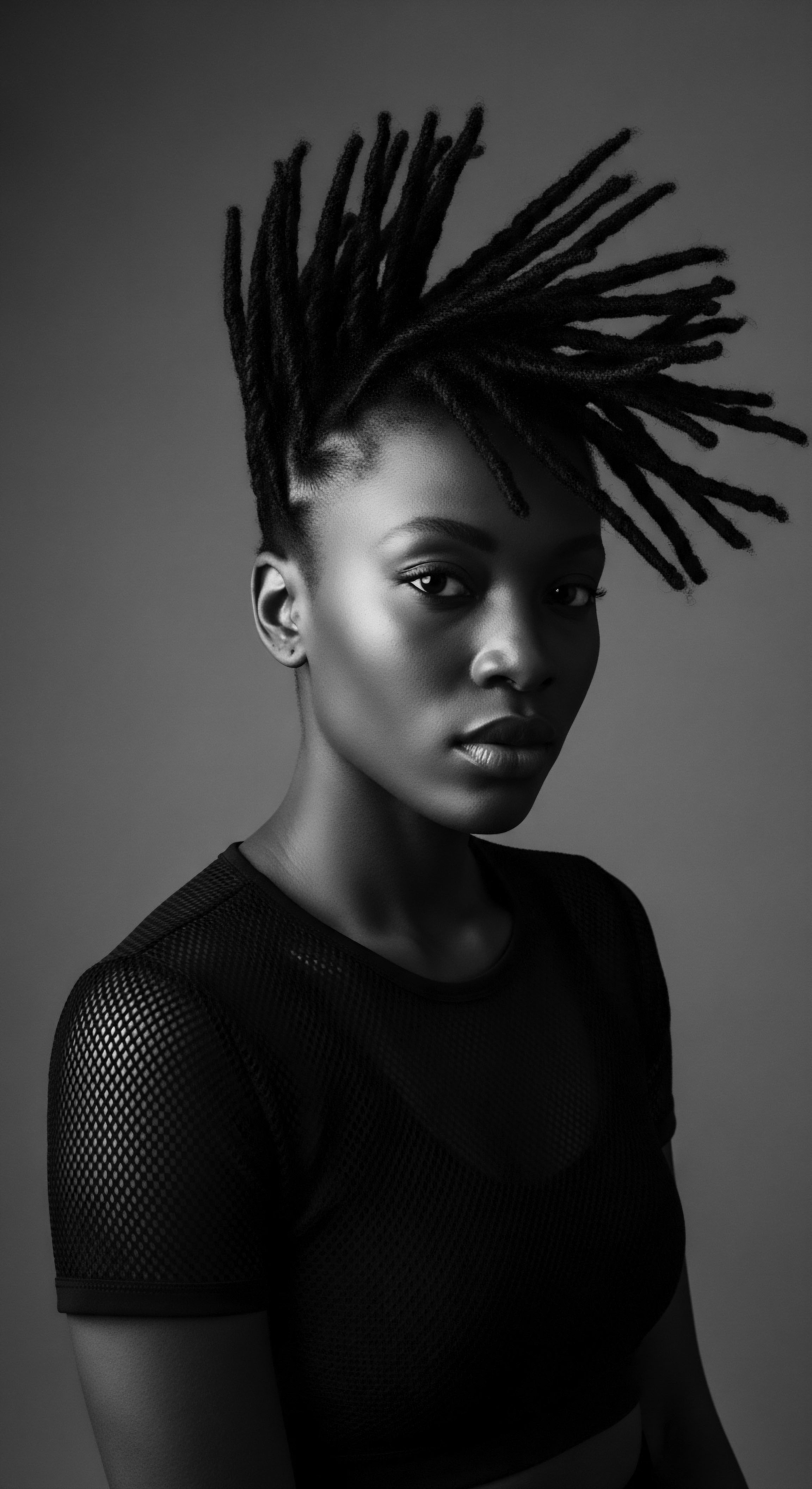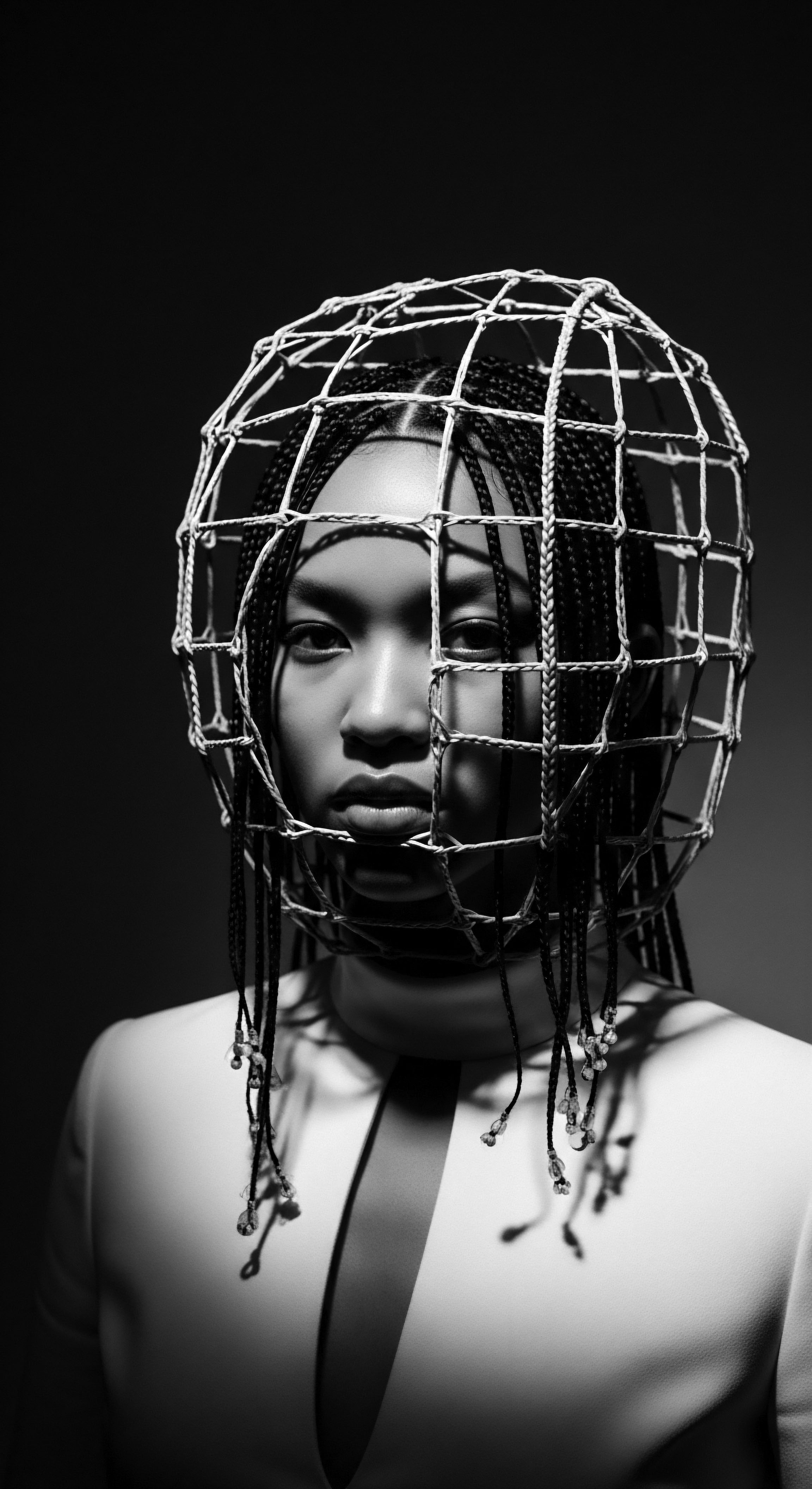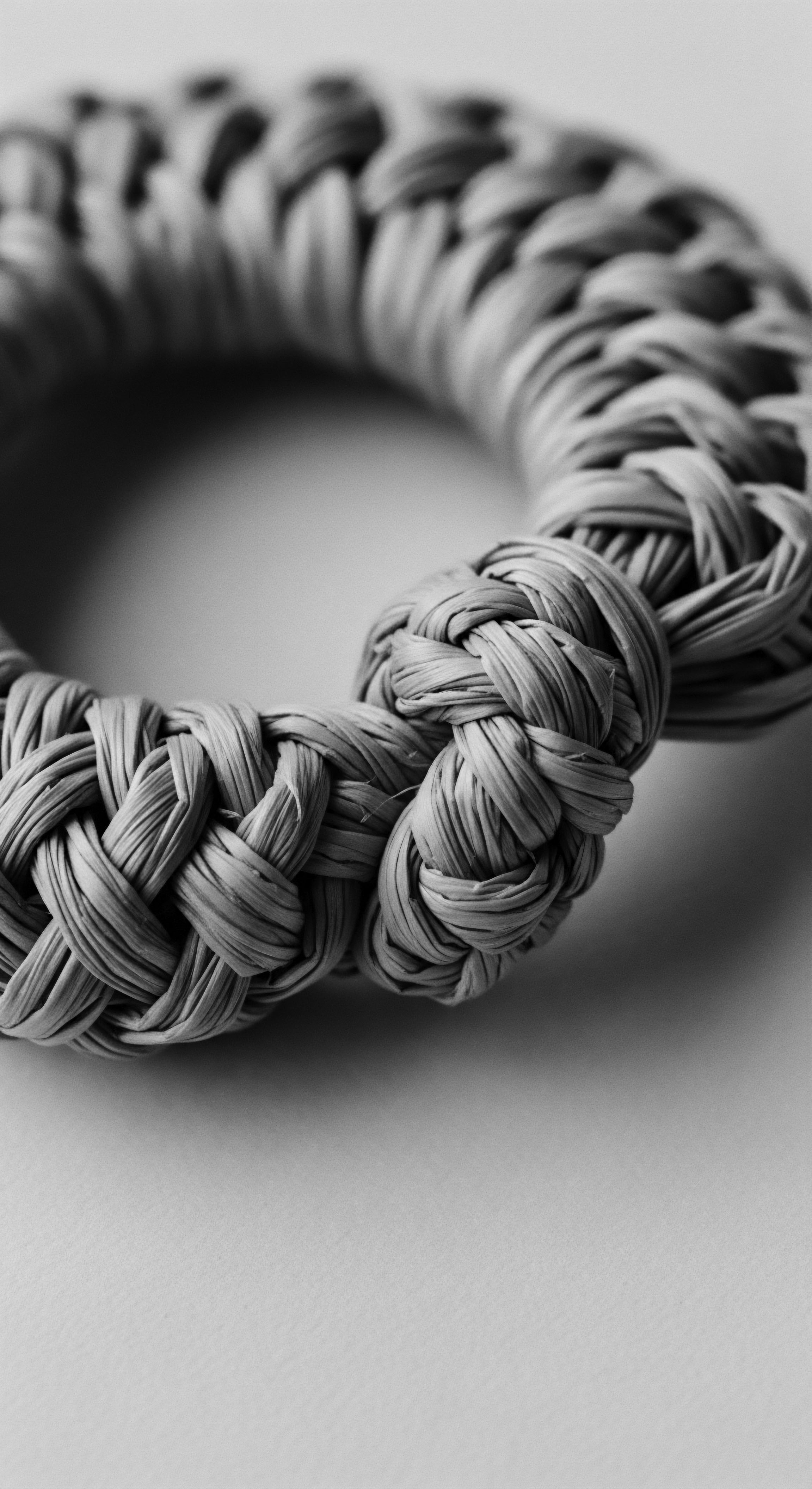
Roots
The gentle twilight descends, and a quiet ritual begins for countless souls with textured hair across the globe. It is a moment often unseen, a personal cadence before the day yields to night. Yet, within this seemingly simple act of preparing hair for slumber—securing it, perhaps with silk or satin—rests a profound echo. Can preserving hair overnight contribute to a deeper connection with cultural heritage?
The answer, etched into the very helix of each strand, is a resounding affirmation, a quiet song sung through generations. It is a dialogue between present practice and ancestral wisdom, a living archive of care and identity.
Consider the hair itself, a remarkable filament of protein, more than mere adornment. For those with coils, kinks, and waves, hair possesses a unique architectural integrity, a genetic blueprint passed down through lineages spanning continents and millennia. Its intricate structure, from the elliptical follicle that shapes its curl to the very distribution of melanin that colors it, speaks volumes of resilience and adaptation. Understanding this elemental biology, this intrinsic nature of textured hair, begins with recognizing its ancient story.
The nightly preservation of textured hair is not a modern innovation; it is a continuation of ancestral dialogues with self and lineage.

Hair Anatomy and Its Ancestral Echoes
The journey into textured hair’s heritage starts with its microscopic architecture. Unlike straight hair, which typically emerges from a round follicle, coily and kinky strands grow from an elliptical or flattened follicle. This shape dictates the curl pattern, causing the hair shaft to twist as it grows. This twisting, while granting unparalleled volumetric beauty and protective capabilities, also creates points of vulnerability.
Each bend and curve presents an opportunity for friction, for moisture loss, for tangling. From the earliest times, societies with textured hair would have observed this inherent tendency, intuitively developing methods to mitigate these challenges.
Think of the hair shaft, its outer cuticle scales lifting slightly at each turn of the helix. These raised scales, while contributing to the hair’s unique light refraction and natural volume, also make it prone to snagging on rough surfaces. The act of covering hair, perhaps with leaves, skins, or later, finely woven fabrics, was an early technological marvel.
It was a practical response to a biological reality, born of a deep, experiential knowledge of the hair’s very being. The wisdom was not codified in scientific papers but lived in the gentle hands of mothers, aunties, and village elders, passed on through observation and shared ritual.
The very concept of what constitutes “healthy” hair for diverse textures has deep roots. It speaks to a heritage where density, sheen, and the ability to retain moisture were indicators of vitality, not merely Western notions of smoothness or straightness. This ancestral understanding informs our approach to care, including the quiet dedication of nighttime preservation, recognizing the hair’s need for protection as it rests.

Traditional Classifications and Lingual Legacies
While modern science categorizes hair types (often using numerical and alphabetical systems), ancestral communities possessed their own rich lexicons for describing hair. These terms were not about mere texture but about identity, status, and community affiliation. Consider the Igbo people of West Africa, who historically used terms describing not just the curl but the style, the adornments, and the social meanings intertwined within. Their language might describe hair as “nkume,” implying a dense, resilient coil, or “ulu,” signifying hair styled in an elaborate, elevated fashion (Okeke, 2005, p.
77). These classifications were living, dynamic systems.
The very concept of an overnight routine, therefore, was implicitly understood within these traditional frameworks. When hair was intricately braided for a ceremonial event, or coiled into elaborate sculptures that could take days to achieve, its preservation through the night was a given. It was an extension of the creative act, a respectful guarding of the artistry and the cultural codes embedded within the style. The distinction between daytime adornment and nighttime care blurred into a continuous act of honoring the hair.

Hair Growth Cycles and Seasonal Rhythms
Hair grows in cycles ❉ anagen (growth), catagen (transition), and telogen (rest). Ancestral communities, though lacking microscopic insights, understood these rhythms through observation of shed hair, new growth, and changes in hair health tied to diet or seasonal shifts. They intuitively grasped the importance of fostering an environment conducive to growth and minimizing loss.
Overnight care, then, becomes a subtle yet powerful intervention within this cycle. By preventing tangles, reducing friction, and maintaining moisture, these nocturnal rituals create an optimal environment for the hair to regenerate and rest, undisturbed by external stressors.
Historical diets and environmental factors also played a significant role. Nutrient-rich foods, often grown and harvested locally, provided the building blocks for strong hair. The humid climates prevalent in many regions of Africa naturally offered more moisture to the hair, influencing traditional care practices. When people from these regions were forcibly displaced, their hair faced new environmental stressors, prompting adaptations in care routines.
The need to protect hair overnight became even more pronounced in climates where moisture was scarce or homes offered less protection from dust and debris. This adaptation, born of necessity, solidified the overnight ritual as a practice of both survival and heritage continuity.
The fundamental lexicon of textured hair, terms like “coil,” “kink,” “curl,” and “wave,” are modern descriptors. Yet, the actions these words describe—the winding, the spiraling, the undulating—have been observed and honored by Black and mixed-race communities for countless generations. The nightly act of preparing hair for sleep is a recognition of these intrinsic qualities, a whisper of appreciation for the hair’s unique journey. It is a quiet affirmation of one’s lineage and a mindful practice of caring for the living inheritance that adorns the head.
- Coil ❉ Tightly wound strands that form small, spring-like shapes, often fragile yet resilient.
- Kink ❉ Very tight, often zig-zag patterns with sharp angles, prone to shrinkage and dryness.
- Wave ❉ Gentle, S-shaped curves, ranging from loose to well-defined, often with natural shine.

Ritual
The day’s demands recede, and the evening air invites a slower pace. Here, in the quietude of personal space, the act of preserving hair overnight transforms from a mere practical step into a deeply resonant ritual. This is where the heritage of care truly blossoms, where ancient protective styling techniques meet the gentle wisdom of nocturnal preparation.
Can preserving hair overnight contribute to a deeper connection with cultural heritage through the continuity of these precise, tender gestures? It absolutely can, acting as a living bridge to the practices of those who came before us, a silent conversation with generations long past.
For Black and mixed-race communities, hair has never solely been a superficial adornment. It is a cultural text, a historical marker, a canvas of identity, and often, a symbol of resilience in the face of systemic oppression. The careful styling of hair, whether for daily life, ceremonial occasions, or to communicate social standing, demanded preservation.
Overnight care, then, was not an afterthought; it was an integral part of the artistic and communal process. The very concept of “protective styling,” so prominent today, finds its deepest roots in these ancestral methods, where practicality and cultural meaning intertwined.

Ancestral Roots of Protective Styling
Across the African continent, and later throughout the diaspora, intricate hairstyling was a revered art form. Braids, twists, cornrows, and various forms of coiling were not just aesthetically pleasing; they served vital purposes. They protected the hair from environmental damage, minimized tangling, and allowed for extended periods between full restyling, which was often a labor-intensive, communal affair. Consider the Fulani braids , characterized by a central plait descending from the crown, often adorned with cowrie shells or beads.
These styles, while visually striking, were also designed for longevity. To maintain their integrity, and indeed, their symbolic weight, safeguarding them during sleep was essential.
The knowledge of how to preserve these styles overnight was passed down through the hands, through observation, through the quiet guidance of matriarchs. It involved strategic wrapping, the use of soft cloths, or even specialized sleeping positions to avoid disturbing intricate patterns. This was not a codified science but an embodied wisdom, a deeply practical skill rooted in the understanding that hair, once meticulously styled, deserved respect and sustained protection.
Overnight hair practices are not just about hair health; they are a tender continuation of a legacy of self-care rooted in ancestral knowledge.

Nighttime Sanctuary The Bonnet and Beyond
The modern silk or satin bonnet, a ubiquitous tool in textured hair care today, has a compelling lineage. While its immediate popularity soared in the 20th century as synthetic fabrics became accessible, its conceptual precursor existed in the form of head wraps and coverings used by African women for centuries. These coverings were worn for varied reasons ❉ modesty, spiritual observance, social status, and, crucially, hair protection. The act of wrapping hair before sleep can be seen as a direct descendant of these practices, adapted and transformed through the transatlantic slave trade and subsequent diasporic experiences.
During slavery, head wraps often became a forced marker of subjugation, yet Black women ingeniously transformed them into symbols of resistance, dignity, and beauty. The practical aspect of protecting hair, which had to be maintained with limited resources and often in harsh conditions, persisted. Overnight wrapping prevented further damage, preserved precious moisture, and kept hair clean. This survival practice, born of adversity, became interwoven with the fabric of daily life.
The contemporary bonnet, then, carries not only the practical legacy of hair protection but also the spiritual legacy of resilience and self-preservation. It is a quiet act of reclaiming agency over one’s own body and heritage.
The materials used also carry significance. Silk and satin, with their smooth surfaces, minimize friction and absorb less moisture than cotton, protecting the hair’s delicate cuticle. This scientific understanding now validates what generations of women instinctively knew ❉ that the right covering makes a difference. The choice of material, the particular way one ties a scarf, or secures a bonnet, are small, personal expressions that echo a larger historical narrative of innovation and care.

Hair Tools and Their Heritage
The toolkit for textured hair care, especially for nighttime preservation, is simple yet powerful, often reflecting the ingenuity of traditional practices.
| Historical Practices Leaf Wraps ❉ Used in some African cultures for both protection and infusing herbal benefits overnight. |
| Modern Adaptations Silk Bonnets ❉ Lightweight, breathable, and friction-reducing for daily overnight use. |
| Historical Practices Mud & Clay Masks ❉ Applied as restorative treatments, sometimes left on overnight, then rinsed. |
| Modern Adaptations Satin Pillowcases ❉ A foundational protection, preventing friction while sleeping. |
| Historical Practices Oil-Soaked Cloths ❉ Used to moisturize and protect hair, often tied on for extended periods. |
| Modern Adaptations Pre-Stretched Scarves ❉ Versatile for securing styles like twists, braids, or coils. |
| Historical Practices The continuity of protecting textured hair during rest reflects an enduring appreciation for its unique needs across time. |
Even something as seemingly simple as a wide-toothed comb or fingers, used gently to detangle hair before securing it for the night, carries a whisper of ancestral tradition. These tools, whether carved from wood in ancient times or crafted from plastic today, serve the same fundamental purpose ❉ to respect the hair’s natural pattern and protect it from breakage, especially during the hours of rest. The very motion of detangling before bed, an act of mindful preparation, becomes a small prayer for the hair’s continued strength and beauty.

Natural Styling and Defining Heritage
Many traditional African hairstyles involved braiding or twisting techniques that were left in for days or weeks. These were, in effect, long-term protective styles. The overnight routine for such styles centered on their maintenance. When hair was twisted or braided while damp, its pattern would be set as it dried.
This was often done during the day, with the overnight protection serving to preserve the definition and prevent frizz. This practical approach to setting and preserving styles speaks to a historical understanding of hair’s properties long before modern styling products.
The act of preserving hair overnight, therefore, is not merely about preventing damage; it is about extending the life of a style, honoring the effort put into it, and respecting the cultural significance it carries. It is a daily reaffirmation of a heritage where hair care is intertwined with identity, art, and community.

Relay
The quiet discipline of preserving hair overnight extends beyond personal care; it acts as a powerful conduit, transmitting a heritage of resilience and self-worth across generations. Can preserving hair overnight contribute to a deeper connection with cultural heritage, not just as a static historical fact, but as a living, dynamic relay of wisdom and identity into the future? The practice is a continuous, evolving conversation, a whisper from the past that grounds us firmly in the present, while guiding our steps forward.
This is where the holistic understanding of textured hair truly comes to life, where the ancestral wisdom of care rituals meets modern scientific validation. The nighttime regimen becomes a conscious act of tending to one’s physical self while simultaneously acknowledging the spiritual and cultural dimensions of hair. It is a silent yet potent declaration of one’s connection to a lineage that has consistently honored hair as a sacred aspect of being.

Personalized Regimens and Ancestral Wisdom
Building a hair care regimen, particularly one that accounts for overnight needs, is deeply informed by ancestral wisdom. For centuries, communities relied on natural ingredients, understanding their properties through trial and error, passed down orally. Shea butter , a staple across West Africa, was known for its intense moisturizing and protective qualities, often applied to hair before intricate braiding or left on overnight to condition. Similarly, coconut oil was widely used in parts of Africa and the Caribbean for its penetrative moisturizing capabilities (Agyeman & Nkansah, 2017, p.
19). These ingredients were not chosen arbitrarily; their efficacy was observed, documented through practice, and integrated into daily life.
A modern personalized regimen, therefore, can draw directly from this rich repository. The decision to use a certain oil, a particular method of twisting hair for the night, or the choice of a protective head covering, becomes a conscious echo of these historical practices. It allows for a deeper appreciation of the wisdom embedded in simple, natural elements and traditional techniques. It moves beyond mere product application to a mindful engagement with one’s heritage.
The enduring practice of overnight hair preservation is a vibrant thread in the continuum of Black and mixed-race cultural identity.
Consider a specific case from the Gullah Geechee communities of the Southeastern United States. Descendants of West and Central African enslaved people, they maintained many ancestral practices, including unique approaches to hair care. Their hair practices, often involving natural oils and specific wrapping techniques, were not just about aesthetics; they were about resisting assimilation and maintaining a tangible link to their African heritage amidst profound hardship. The careful nightly preparation of hair, sometimes for protection against harsh elements during labor, became a quiet act of preserving cultural distinctiveness.
(Joyner, 1984). This intimate, often solitary ritual, performed in the dim light of evening, connected individuals not only to their immediate family but to a collective history of survival and cultural preservation.

Nighttime Protection and Hair Health
The scientific understanding of friction and moisture retention now offers a clear explanation for the benefits of overnight hair preservation, validating long-held ancestral practices. When hair rubs against rough surfaces like cotton pillowcases, it creates friction, leading to frizz, breakage, and moisture loss. A satin or silk bonnet, or even a pillowcase, significantly reduces this friction, allowing the hair cuticle to remain smooth and intact. This simple act of protection helps to preserve the hair’s natural oils, preventing dryness and tangling that would otherwise occur.
Moreover, many traditional nighttime regimens involve the application of natural emollients or humectants. For instance, aloe vera , used in many traditional healing practices, can be applied overnight to soothe the scalp and provide moisture. These practices align with modern dermatological understanding of scalp health and hair hydration. The knowledge, though acquired through different means, converges on the same beneficial outcomes ❉ healthy, protected hair.
The concept of wrapping hair, often seen today with head wraps worn publicly, also finds its private, nocturnal parallel. The dubu or head tie among women of certain West African groups like the Hausa, for example, was a public display of beauty and modesty. The same care taken for public presentation extended to overnight protection, albeit with different materials or methods. The principle remained consistent ❉ hair is a sacred trust, demanding constant vigilance and gentle handling.

Addressing Challenges with Ancestral Insight
Even common hair challenges, like excessive dryness or breakage, can be approached with ancestral insight, often through a lens of nighttime care.
- Dryness ❉ Historically addressed by deep oiling with substances like Palm Oil or unrefined shea butter left on overnight, often covered to enhance absorption.
- Breakage ❉ Minimized by gentle styling, particularly braiding or twisting hair down before sleep, a method that reduces daily manipulation and friction.
- Scalp Irritation ❉ Treated with herbal infusions or pastes like Henna or neem , sometimes applied as an overnight mask to calm and cleanse.
These solutions were often integrated into nightly routines, becoming preventative measures rather than reactive treatments. The wisdom was in understanding the hair’s needs and proactively providing nourishment and protection, especially during extended periods of rest when the body naturally repairs itself. This cyclical approach, echoing the rhythms of nature, is a hallmark of ancestral wellness philosophies.

Holistic Wellbeing and Hair Heritage
The connection between hair and overall wellbeing is not a contemporary concept. Many African spiritual traditions hold hair as a conduit for spiritual energy, a connection to the divine, and a symbol of wisdom. The meticulous care of hair, including its overnight preservation, became a meditative practice, a moment of introspection and connection to something larger than oneself. It transcended the purely physical, touching upon mental tranquility and spiritual grounding.
This holistic view means that preserving hair overnight is not merely about aesthetics or preventing damage. It is about honoring a part of oneself that carries deep historical and spiritual weight. It is an act of self-love, passed down through generations, often in the face of immense pressure to conform to Eurocentric beauty standards.
By engaging in these practices, individuals with textured hair are not simply caring for their strands; they are nurturing a tangible link to their ancestors, affirming their cultural identity, and contributing to the ongoing story of Black and mixed-race hair heritage. It is a powerful, silent form of resistance and reclamation, carried out in the quiet hours of night.

Reflection
In the hushed moments before dawn, as the world prepares to stir, the protected coils and curls rest, holding within them not just the promise of another day’s beauty, but the profound legacy of generations. The question of whether preserving hair overnight contributes to a deeper connection with cultural heritage finds its answer in the silent, consistent dedication to these practices. It is a dialogue that transcends words, spoken through the gentle caress of silk, the careful plaiting of strands, the conscious choice to honor what has been passed down.
Roothea understands hair as a living, breathing archive, each strand a testament to resilience, creativity, and identity. The wisdom held in the overnight ritual is a vibrant thread in this ongoing story, a continuous act of remembrance and reclamation. It reminds us that our hair is more than biology; it is biography. It is a story told not just in genes, but in the enduring practices of care that have navigated centuries of change.
From the hands that first instinctively protected precious curls with natural fibers, to the discerning choice of a satin bonnet today, the lineage of care is unbroken. This seemingly simple nightly act strengthens not only the hair itself but also the soul’s connection to its roots, ensuring the heritage of textured hair continues its luminous journey.

References
- Agyeman, P. A. & Nkansah, A. A. (2017). Traditional Medicinal Plants and Their Uses in Ghana. Scientific Publishing.
- Joyner, C. W. (1984). Down by the Riverside ❉ A South Carolina Slave Community. University of Illinois Press.
- Okeke, C. I. (2005). Igbo Art and Culture ❉ A Historical Overview. University Press Limited.
- Byrd, A. D. & Tharps, L. D. (2001). Hair Story ❉ Untangling the Roots of Black Hair in America. St. Martin’s Griffin.
- Mercer, K. (1994). Welcome to the Jungle ❉ New Positions in Cultural and Gender Theory. Routledge.
- White, M. (1999). Slave Narratives. Dover Publications.
- Jackson, R. L. (2002). The Psychology of Hair and Hair Care. Blackwell Publishing.
- Banks, I. (2000). Hair Matters ❉ Beauty, Power, and Black Women’s Consciousness. New York University Press.
- Opoku, K. A. (1978). West African Traditional Religion. FEP International Private Limited.
- Afro Hair, S. A. (2018). The Science of Black Hair ❉ A Comprehensive Guide to Textured Hair Care. The Hair Scientist.
